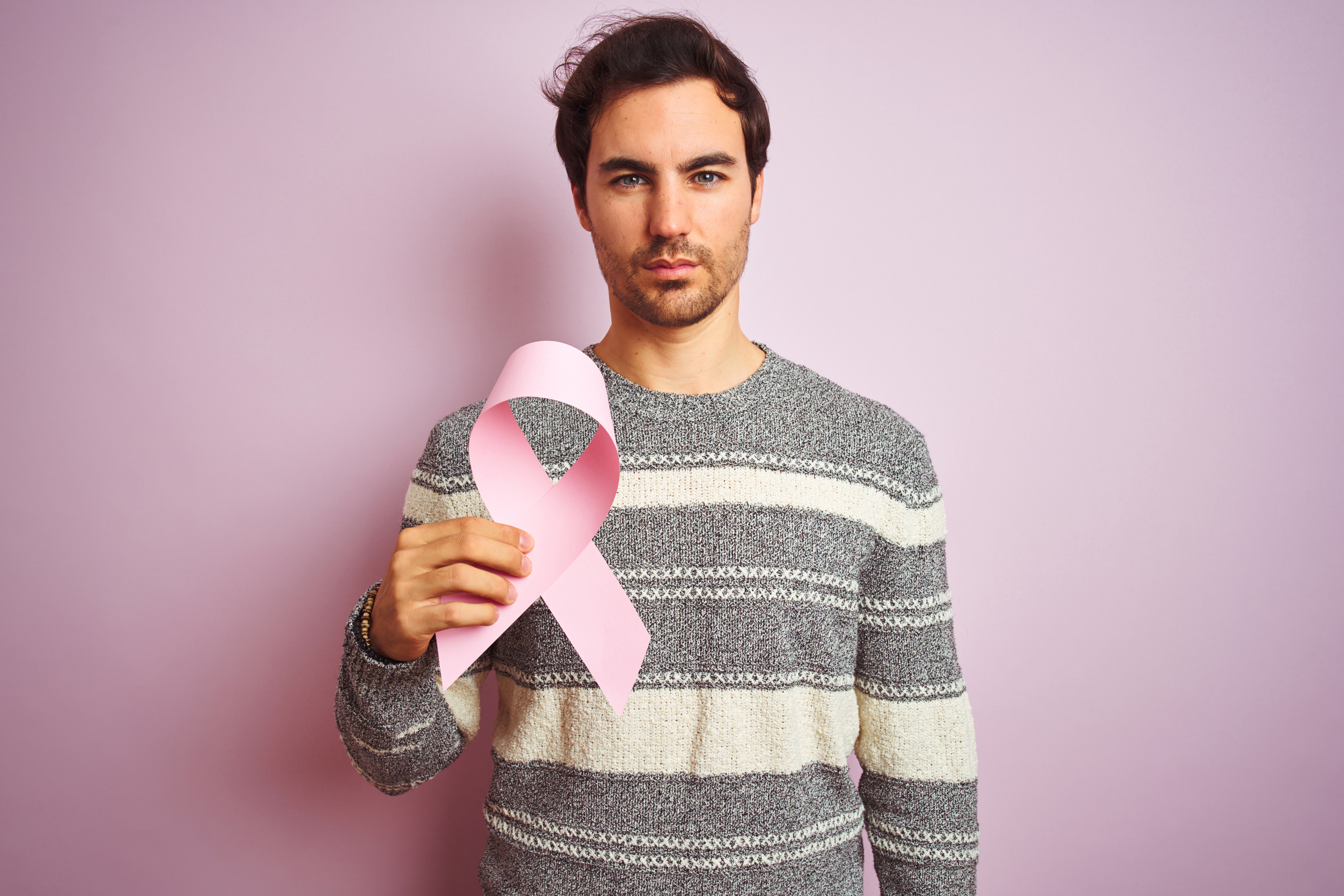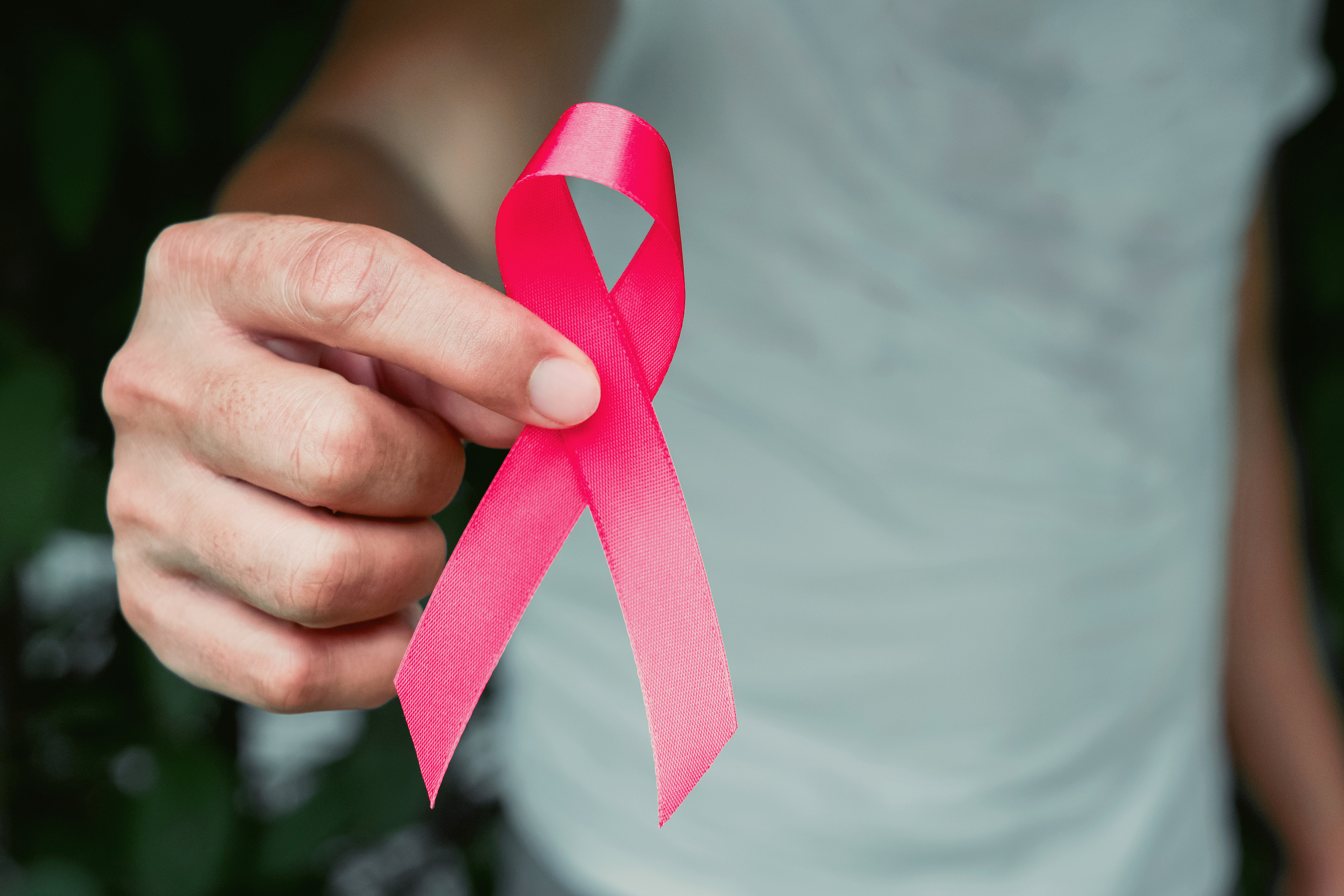When you hear about breast cancer, it is most often related to a woman being diagnosed with the disease. However, on rare occasions, ≤ 1%, a man will be diagnosed with breast cancer.
Typically, it occurs in older men but can occur at any age. Breast cancer affects men in the same location as a woman, in the breast tissue.
This tissue is composed of ducts and lobules (glands) but since men have fewer female hormones than women, the breast tissue does not grow as much.
This tissue is composed of ducts and lobules (glands) but since men have fewer female hormones than women, the breast tissue does not grow as much.
These changing cells can form a lump or a “tumor”. These fast-growing cells can then spread to nearby tissue and lymph nodes or other parts of your body if medical attention isn’t received promptly.

These are some known factors that can increase the risk of male breast cancer:
- Advanced age – Male breast cancer is most often diagnosed in men 60 or older.
- Family history of breast cancer – Men that have close family members with breast cancer are at an increased risk for breast cancer.
- Estrogen exposure – Some hormone therapies for prostate cancer have estrogen and may put you at an increased risk for breast cancer.
- Obesity – Fat cells have an increased number of female hormones, which put you at an increased risk for breast cancer.
- Other diseases such as testicular cancer or liver disease can reduce male hormones and increase female hormones, putting you at an increased risk for breast cancer.
- Genetic diseases such as Klinefelter’s Syndrome can reduce male hormones and increase female hormones, putting you at an increased risk for breast cancer.
If you have signs or symptoms of breast abnormalities, see your doctor as soon as possible. He or she can do a physical exam and order further testing to determine the exact cause of these abnormalities.
Some possible signs and symptoms of breast cancer are:
- A painless lump that won’t go away
- Swelling to the axillary (armpit) area
- Thickening of breast tissue or a dimpling appearance
-
Changes to the nipple area
- pulling inward
- scaling
- redness or changes in skin color
- nipple discharge
A diagnostic workup can be done to confirm a breast cancer diagnosis. When you visit your physician, you can expect one or more of the following:
- Physical exam
- Personal and family history review
-
Imaging studies
- Diagnostic mammogram and/or ultrasound
- Bilateral breast MRI
- PET/CT or CT/bone scan if signs of metastatic disease are present
-
Genetic testing if you have a family history of breast cancer
- Inherited mutations, such as BRCA 1 and 2, may put you at a higher risk for getting breast cancer
-
Breast biopsy
- A core needle biopsy is a test that has a wide hollow needle that removes small pieces of tissue from the suspicious area. A pathologist will then analyze the tissue’s cells to determine the diagnosis. It can take several days to get the results of the biopsy.
- Less frequently, a fine needle aspiration is done to determine the diagnosis. This test is typically done to examine cells near the lymph node(s) in the axillary area. The test draws cells or fluid into a small hollow needle that is sent to a pathologist for analysis. It can take several days to get the results of the biopsy.
The most common type of male breast cancer is called adenocarcinoma. This type of carcinoma starts in the breast ducts or lobules (glands). Less common types of carcinomas are called sarcomas, angiosarcomas, phyllodes, or Paget’s Disease. These carcinomas start in the cells of fat, connective tissue, or muscle. In some cases, a combination of different types of cells are found.

-
Cancer that begins in the milk ducts is called ductal carcinoma. Nearly all male breast cancer is ductal carcinoma.
-
Ductal carcinoma in situ (DCIS)
- DCIS is considered a Stage 0, non-invasive breast cancer, meaning it has not spread beyond the walls of the ducts to the surrounding breast tissue. DCIS is very curable type of cancer because it has been caught in the early stages of development.
-
Invasive ductal carcinoma (IDC)
- IDC is the most common type of male breast cancer, affecting 8 out of 10 men diagnosed with the disease.
- IDC is an invasive breast cancer, meaning it has spread beyond the walls of the ducts into the surrounding breast tissue. At this point, it has the potential to spread to other parts of the body if it is not treated in a timely manner.
-
Ductal carcinoma in situ (DCIS)
-
Cancer that begins in the glands is called lobular carcinoma.
- Lobular carcinoma in men is rare, about 2%, because men have fewer lobules in their breast tissue than women.
-
Invasive lobular carcinoma (ILC)
- ILC is an invasive carcinoma, meaning it has spread outside of the lobules (glandular tissue) into the surrounding breast tissue.
-
Rarer types of male breast cancer include:
-
Paget's disease of the nipple
- This type of carcinoma is rare and accounts for approximately 5% of breast cancers in men. It starts in the ducts and spreads to the nipple and sometimes the areola area (circular area around the nipple).
-
Inflammatory breast cancer (IBC)
- This type of carcinoma is rare in men but is an aggressive type of breast cancer causing the breast to become swollen, warm and red. It may be tender to touch and mistaken for infection.
-
Paget's disease of the nipple
After being diagnosed with breast cancer, you will likely be referred to a surgeon and/or a medical oncologist. The type of treatment that is recommended to you will depend on the size, location, and stage of your disease.
Local Treatments:
Surgery is a local treatment that is performed by a general surgeon or surgical oncologist, a physician who has special training in procedures for diagnosing, staging, and removal of cancerous growths.
There are a variety of different types of breast surgeries, but the most common type of surgery for men is called a mastectomy. Axillary staging, a biopsy of underarm lymph nodes, is required in most patients often using a technique called sentinel lymph node mapping.
The goal of a mastectomy is the complete removal of the breast, removal of the underlying tumor with negative margins, and to determine if the tumor has spread to the lymph nodes.
Speak to your surgeon to learn more about your surgical options along with the risks and benefits of the procedure.
Radiation therapy is a local treatment that is performed by a radiation oncologist, a physician who specializes in the use of radiation therapy to treat the affected area(s) after surgery.
Breast radiation therapy uses high energy x-rays to destroy any microscopic cells that may be left behind after your breast surgery and helps reduce your risk of recurrence of breast cancer.
Radiation therapy would be recommended for the following reasons:
- If your tumor is ≥ 5 cm (about 2 inches)
- If you have positive surgical margins or the cancer is very close to the edge of the tissue that has been removed
- If the tumor involved the skin or muscle
-
Lymph node involvement
- Usually, if you have three or more positive nodes, however, patients with 1-2 positive lymph nodes may require radiation
Typically, radiation is given in an out-patient setting after the surgical wound has healed, which is approximately 4 weeks after surgery. Treatment is given on weekdays and can be up to 5-6 weeks. Each session is usually very quick, 15 minutes or less.
Speak to a radiation oncologist to learn more about your treatment options along with the risks and benefits of the procedure.
Systemic Treatments:
At some point during your treatment, you will see a medical oncologist, a physician who has special knowledge and training in cancer behavior and growth. They will design a treatment plan for you based on their findings. In addition, they will discuss the risk of your cancer coming back after you have completed treatment.
The medical oncologist prescribes medication(s) to treat breast cancer systemically, meaning the medication(s) targets cancer cells anywhere in the body, not just the breast. The medication can be given orally or through an intravenous line which enters the bloodstream. The form of medication(s) you receive will depend on the type and stage of your disease.
Following are examples of systemic treatments:
-
Chemotherapy
- An anti-cancer medication that is either infused intravenously or given orally to fight cancer.
- The medication travels throughout the body to kill cancer cells.
- Chemotherapy is not indicated for all breast cancer patients, especially those with an early stage disease with favorable prognostics.
-
Your physician will weigh many factors to determine if you will need chemotherapy or not:
- Prognostic status (estrogen, progesterone, HER-2)
- Size and location of the tumor
- Stage of the disease
- Patient general health status
-
Hormone-Blockers or Endocrine Therapy
- Medications used for breast cancers that are affected by hormones such as estrogen and progesterone are called hormone-blockers or endocrine therapy.
- The cancer cells have receptors (proteins) which attach to estrogen and progesterone and the hormones “feed” the cells, making them grow out of control and spread.
- The hormone-blockers stop the hormones from attaching to the receptors or block the body's ability to produce hormones.
-
Targeted Therapy
- Targeted therapy is medication that target changes in cells that cause cancer. It is typically used in combination with chemotherapy or another targeted therapy and can be continued after chemotherapy is completed.
- Targeted therapy is not a type of chemotherapy
-
HER-2 positive breast cancer is due to too much of a growth-promoting protein called HER-2 on the cell’s surface.
- This type of cancer tends to grow and spread very aggressively. Fortunately, medications that target this protein have resulted in great success rates over the years. The drugs can be used to treat both early stage and late stage breast cancers
-
Immunotherapy
- Immunotherapy is a type of targeted biological therapy that helps boost your immune system to fight cancer. Drugs such as Pembrolizumab (Keytruda) are often used in combination with chemotherapy to treat cancer that cannot be removed with surgery (unresectable), and in some triple negative breast cancers (TNBC).
- Specific eligibility criteria must be met for these drugs and your medical oncologist will help determine which treatment options are best for you.
Speak to your medical oncologist to learn more about your treatment options along with the risks and the benefits of each.
Trying to balance your healthcare regimen and family life can become very challenging, making it hard to cope during this difficult time. It is not uncommon to be affected both physically and emotionally.
Remember, you are not alone during this journey. Share your feelings with your partner and talk to your medical professionals about getting support. Studies show that psychotherapy or “talk therapy” has proven value. Speaking with professionals can help validate your emotions and give you clarification by putting these feelings into perspective.
Also, think about joining a local or national breast cancer support group. Support groups may be available in person, online, or through social media and can help you work through your emotions while you go through treatment. Men that have been through this journey can provide a “safe haven” for you with valuable information and guidance and can connect you to resources in your community.
